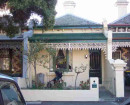Back to search results
Hillsley
90-92(part) Robinson Road and 94-104(part) Robinson Road NARRE WARREN NORTH, CASEY CITY
Hillsley
90-92(part) Robinson Road and 94-104(part) Robinson Road NARRE WARREN NORTH, CASEY CITY
All information on this page is maintained by Casey City.
Click below for their website and contact details.
Casey City
-
Add to tour
You must log in to do that.
-
Share
-
Shortlist place
You must log in to do that.
- Download report

Hillsley - Shearing Shed








On this page:
Statement of Significance
What is significant?
Hillsley Homestead Complex and Garden located at 90-104 Robinson Road Narre Warren North. The significant elements of the place are located across two titles. Those on the land at 90-104 Robinson Road, Narre Warren North are:
- The Victorian brick homestead (c.1870) and its later additions (c.1935);
- The driveway form and layout from Robinsons Road to the homestead including the turning circle, and associated planting of a variety of mature trees on both sides;
- The rare specimens of Totara, Plum Pine and Himalayan Oak (included as plantings along the driveway);
- The boundary plantings of trees, particularly those north of the house, including specimens of Smooth Arizona Cypress, Algerian Oak, English Elm and English Oak;
- The interwar outbuilding
- The mature garden located to the front and sides of the residence, including all mature trees and shrubs, any paths and their layout and all garden features. Of particular interest are the mature specimens of Coral Tree, Bull Bay Magnolia, Illawarra Flame Tree, Holly, Irish Strawberry Tree, Oleander and Windmill Palm.
- The stone and earth cool store, located on a hill north east of the main residence;
- The vernacular corrugated iron and timber shearing shed and yards, located north east of the main residence
The modern corrugated iron shedding, garages and fences are not significant.
How is it significant?
Hillsley Homestead Complex and Garden is of local historical, aesthetic and scientific (botanical) local significance to the City of Casey.
Why is it significant?
The farming complex at Hillsley is of historical significance as a comparatively rare intact example of a farm complex within the municipality, which demonstrates, through its fabric the history and variety of agricultural pursuits in the Narre Warren North area over a period of 100 years. The original homestead was constructed as the centre of a farming enterprise focused on orcharding and cropping, demonstrated by the early surviving cool store, which, judging by its construction, dates from the 1870-1900 period. By the 1890s, the property was primarily focused on grazing and vegetable growing, the shearing shed being evidence of the grazing pursuits, while the cool store continued to be used for storing vegetables. By the interwar period, orcharding and grazing had once again become the primary source of income for the family. The house also demonstrates historical changes in fashion, the Robinson family fortunes over time, constructed as a fine residence in the 1870s, it was extended and ‘modernised’ through the addition of render to its chimneys and sills, and a new wing of the house in c1935. There are relatively few examples of farming complexes with a variety of the original residence and intact farm buildings surviving within the locality. (Criterion A and B)
It is of aesthetic significance for the fine Victorian residence, designed by George Washington Robinson and constructed in 1872, in its elevated garden setting. Several of the trees are also of outstanding aesthetic value for their size and form, including the Bull Bay Magnolia and Coral Tree in particular. (Criterion E)
The range and variety of unusual specimens of trees in the garden are of scientific interest (botanical) as some are particularly rare in residential gardens of the late nineteenth and early twentieth century, particularly the Himalayan Oaks and the Totara and Plum Pine specimens (Criterion B and F).
It is of aesthetic significance for the fine Victorian residence, designed by George Washington Robinson and constructed in 1872, in its elevated garden setting. Several of the trees are also of outstanding aesthetic value for their size and form, including the Bull Bay Magnolia and Coral Tree in particular. (Criterion E)
The range and variety of unusual specimens of trees in the garden are of scientific interest (botanical) as some are particularly rare in residential gardens of the late nineteenth and early twentieth century, particularly the Himalayan Oaks and the Totara and Plum Pine specimens (Criterion B and F).
Many of the garden plantings and individual specimens of trees are rare in cultivation.
(Criterion B)
Show more
Show less
-
-
Hillsley - Physical Description 1
Hillsley is a substantial rural homestead complex set in the remnants of a large garden at the rise of a hill, accessed by a tree lined driveway from Robinson Road. The complex comprises a large Victorian brick homestead (c1870) in a mature garden setting, a glasshouse, vernacular stone and earth cool-store, shearing shed and outbuilding, set within a broad rural landscape, on a rise half way up a large hill. The residence is asymmetrical in plan, with undecorated verandah returning on both sides, and original chimneys and joinery. The house has a series of double-hung six-paned windows with characteristic arched lintels. Later additions (c.1935), in timber and brick are evident towards the rear of the property, and include a kitchen, bedroom, dairy and office. The original house site (pre 1870) is located approximately 370m north of the main residence, marked by a mature Cupressus semprevirens (Italian Cypress) and some other exotic trees.
The complex is accessed by a long tree lined driveway which comprises a mix of specimens, including Araucaria cunninghamii (Hoop Pine), Cupressus macrocarpa (Monterey Cypress), Chamaecyparis lawsoniana (Lawson’s Cypress), Eucalyptus maculata (Spotted Gum), Grevillea robusta (Silky Oak), Cedrus atlantica (Atlas Cedar), Quercus robur x canariensis (Hybrid oak), Podocarpus totara (Totara), Podocarpus elatus (plum pine), Quercus leucotriophora (Himilayan Oak), Pinus canariensis (Canary Island Pine), Schinus molle (Peppercorn), Cedrus atlantica (Atlas Cedar), Olea European (Olive) and Syzigium australe (Brush Cherry or Lillypilly. All of these trees are of a significant age, and many, such as the Plum Pine, Totara, Himilayan Oak are rare in cultivation and exhibit an excellent size. Other plantings are located around the boundary fence and cow paddock to the north of the homestead. These include Cedrus atlantica (Atlas Cedar), Araucaria cunninghamii (Hoop Pine), Podocarpus elatus (Plum Pine), Chamaecyparis lawsoniana (Lawson’s Cypress), Quercus suber (Cork Oak), Cupressus arizonica (Smooth Arizona cypress), Quercus canariensis (Algerian Oak), Quercus canariensis (Canary Island Oak), andUlmus procera (English Elm).
The garden, located immediately west of the homestead is overgrown, but exhibits a rich diversity of shrubs and trees including a fine specimen of Magnolia grandifolra (Bull Bay Magnolia) and a specimen of outstanding size of Erythrina sp (either x skyesii or caffra) Coral Tree, as well as the remains of extensive beds of Azalea, Rhododenderon and underplantings of shrubs, creepers, lillies and groundcovers. Other trees which are of significance within the garden are the Ilex aquifolium (Holly), Brachychiton acerifolius (Illawarra Flame Tree), Arbutus unedo (Irish Strawberry Tree), Nerim oleander (Oleander), Syzigium australe (lillypilly), Prunus laurocerasus (Cherry laurel) and Trachycarpus fortunei (Windmill Palm).
The cool-store, located on the hill behind the main residence is a vernacular structure, part cut out of the side of the hill and part walled with local field-stones, which form a wall on the western side. The cool-store is in ruinous condition.
The shearing shed, located approximately 90 metres north east of the main residence is a simple vernacular structure of corrugated iron and timber, and appears to date from the late nineteenth century or early twentieth century.
Three outbuildings are located immediately north east of the residence. The central of the three outbuildings is a modest interwar outbuilding constructed of corrugated iron, used to store machinery. There are other more modern sheds on either side of the interwar shed, and a large garage/shed on the northern boundary fence of the homestead block.Hillsley - Historical Australian Themes
Developing Primary Production
Heritage Study and Grading
Casey - Casey Heritage Study
Author: Context Pty Ltd
Year: 2004
Grading: LocalSelect Review of Casey Heritage Places, Review of sites for proposed Heritage Anomalies Amendment
Author: Context Pty. Ltd.
Year: 2018
Grading: Local
-
-
-
-
-
Narre Warren North Township
 Casey City
Casey City -
Aranmore
 Casey City
Casey City -
House and Garden (former Treeby)
 Casey City
Casey City
-
'Boonderoo', House and Outbuildings
 Greater Bendigo City
Greater Bendigo City -
'Riverslea' house
 Greater Bendigo City
Greater Bendigo City -
1 Adam Street
 Yarra City
Yarra City
-
-









